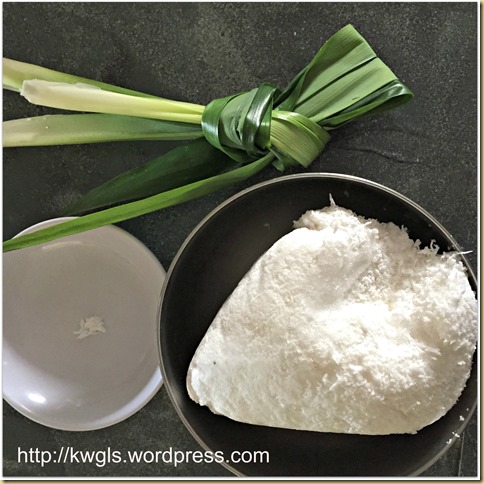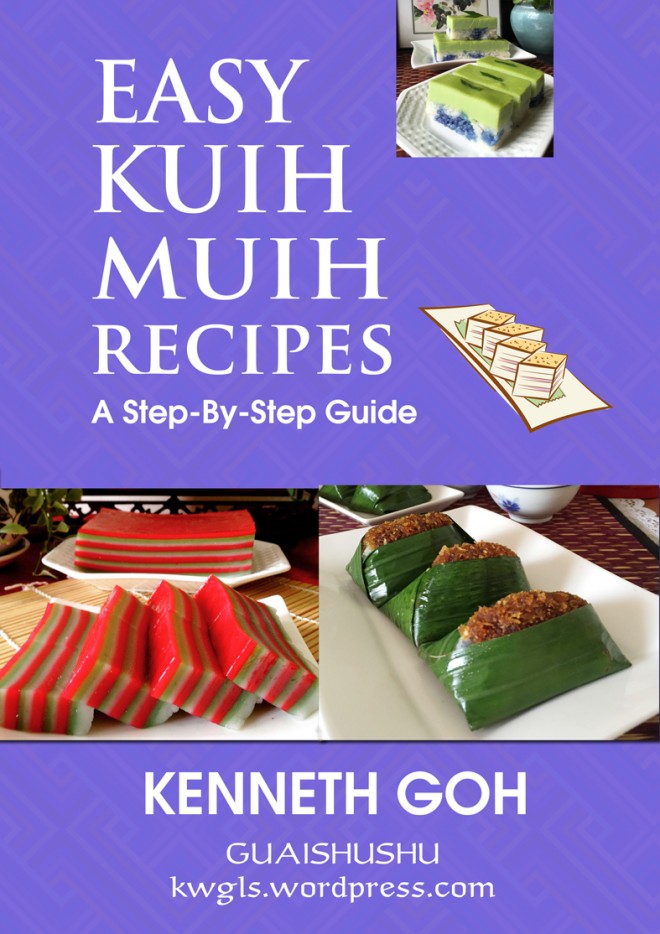
INTRODUCTION
I have seen a kuih that looked rather similar with this kuih in Bengawan Solo made of sago balls.. It was called Sagu Melaka. Possibly such name was called because gula melaka was used in the middle layer and coconut milk was added for the first white layer..
However, in Malaysia especially in the East Coast states of Peninsular Malaysia, this kuih was called kuih bronok or Kuih bronok Sagu. As per Malay Wikipedia, kuih bronok is a Malay delicacy that is made of sago balls and eaten with shredded coconut.
“Kuih Beronok atau juga dikenali sebagai beronok sagu merupakan sejenis kuih tradisional Melayu. Ia dibuat daripada sagu biji atau juga dikenali sebagai sagu mata ikan. Kuih Beronok ini dimakan bersama dengan kelapa parut.” (Source: http://ms.wikipedia.org/wiki/Kuih_bronok)
There is no unwritten rules that the kuih must be red or green. Both are for colouring and to a certain extent for some flavouring as all should know that sago is tasteless and transparent. Red colour is a striking colour and most sold in the stores are red colour.
The flavouring commonly used by our Malay brothers are air bunga or rose water possibly because of the historical influence of Middle East cuisines. If you like air bandung, a type of rose flavour drinks, you may like the flavour. Though the price of rose water is very cheap and can be easily purchased in Indian Muslim or Malay provision stalls, this is optional since you just need 2-3 tablespoons of such flavour.
“Rose water is a flavoured water made by steeping rose petals in water. It is the hydrosol portion of the distillate of rose petals, a by-product of the production of rose oil for use in perfume. It is used to flavour food, as a component in some cosmetic and medical preparations, and for religious purposes throughout Europe and Asia. Rose syrup is made from rose water, with sugar added. Rose water has a very distinctive flavour and is used heavily in Persian and Middle Eastern cuisine—especially in sweets such as nougat, gumdrops, raahat and baklava. For example, rose water is used to give some types of Turkish delight their distinctive flavours.” (Source: https://en.wikipedia.org/wiki/Rose_water)
As for Pandan flavour sago balls, I have used the ready made from the stores. Traditionally, there is no other variation except the red colour rose water version. Apparently, you can also add Gula Melaka and coconut milk to the sago balls like what is sold in Singapore’s Bengawan Solo.
WHAT IS REQUIRED
Servings: Prepare an 9” diameter tray of Kuih bronok sago
-
250 grams of white sago balls
-
250 grams of Pandan sago balls
-
200 grams of castor sugar
-
1-2 tablespoons of rose water (optional)

Steamed shredded coconut
-
200 grams of grated coconut
-
Pinches of salt
-
3-4 pandan leaves
STEPS OF PREARATION
-
In a steamer, place the grated coconut, 1/4 teaspoon of salt and the pandan leaves. Steam in the steamer for about 10-15 minutes or until the pandan leaves are soft. Castor sugar to taste can also be added.
-
For the white sago balls, add 3-4 drops of red colouring and the rose water. Soak both red and green sago balls in cold water for at least 1/2 hour or when the balls cannot expand anymore. Drained away the excess water and add in the 100 grams of sugar each to both green and red sago balls. Stir until well mixed.
-
Grease a baking tray and get ready a pot of boiling water capable of steaming about 30 minutes.
-
Transfer the red sago balls to the steamer, level it and let it steams for about 5 minutes such that the red layer is slightly cooked.
-
Open the lid, add the green sago balls. Level it and steam under high heat for 25-30 minutes until the sago balls turn transparent. Best to cool completely before cutting into pieces and served with shredded coconuts. If desired, some castor sugar can be added to the shredded coconut if a sweeter version is preferred. It can be served cold by keeping in fridge as a dessert.
CONCLUSION
This kuih yields a very QQ texture when completely cold. It is especially fun to chew when it is chilled. Whether coloured or not, rose water or not is up to readers to desired. If preferred, readers can substitute the castor sugar with palm sugar such as Gula Melaka, and it will yield a brown colour kuih bronok sagu .
Hope you like the post today. Cheers and have a nice day.
-
For more recipes, you can refer to my RECIPE INDEX (updated as at 13 March 2015) here and you can follow me at PINTEREST or visit the blog’s FACEBOOK PAGE to keep abreast of my future posts. Also follow me at INSTAGRAM or TSU, a new social network for some more personal sharing other than recipes.
-
If you are a Pinterest user and you are interested to have more recipes, you can join or follow this Pinterest Board set up by me where there are more than 2600 recipes worldwide and pinned by various bloggers: FOOD BLOGGERS AND FOODIES UNITED PINTEREST BOARD.



















